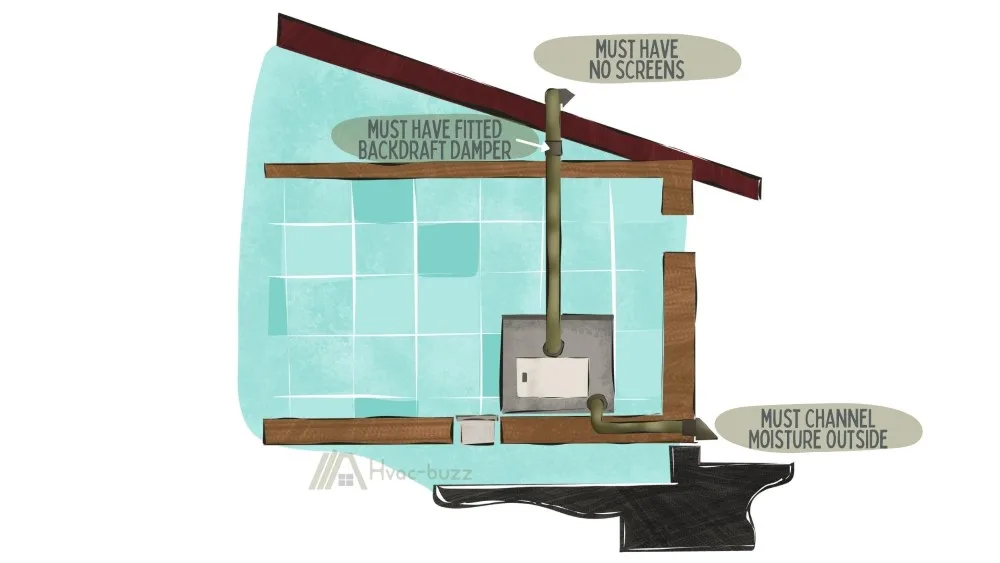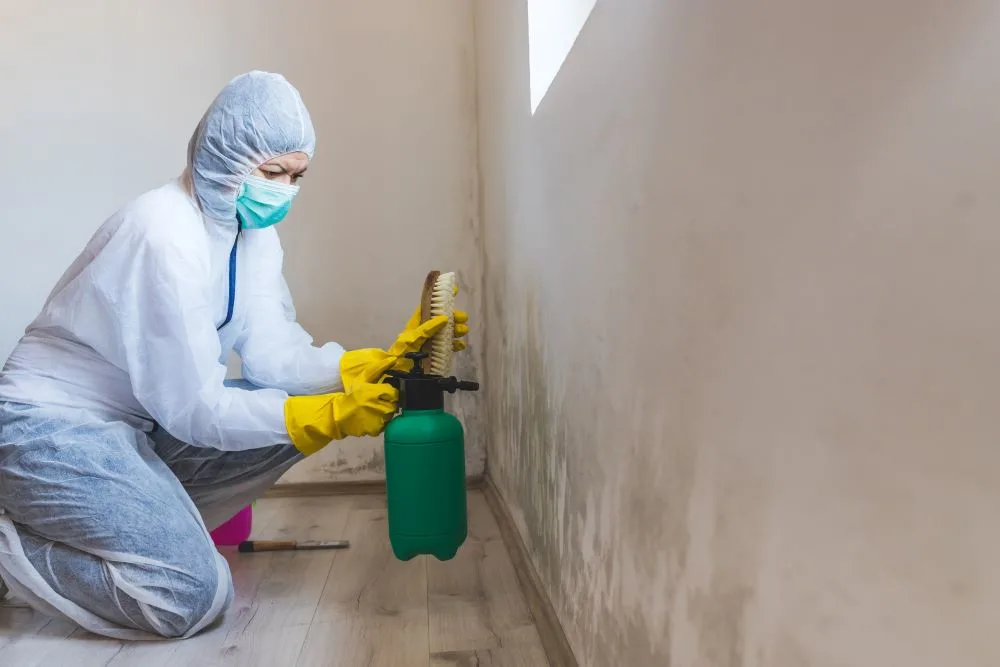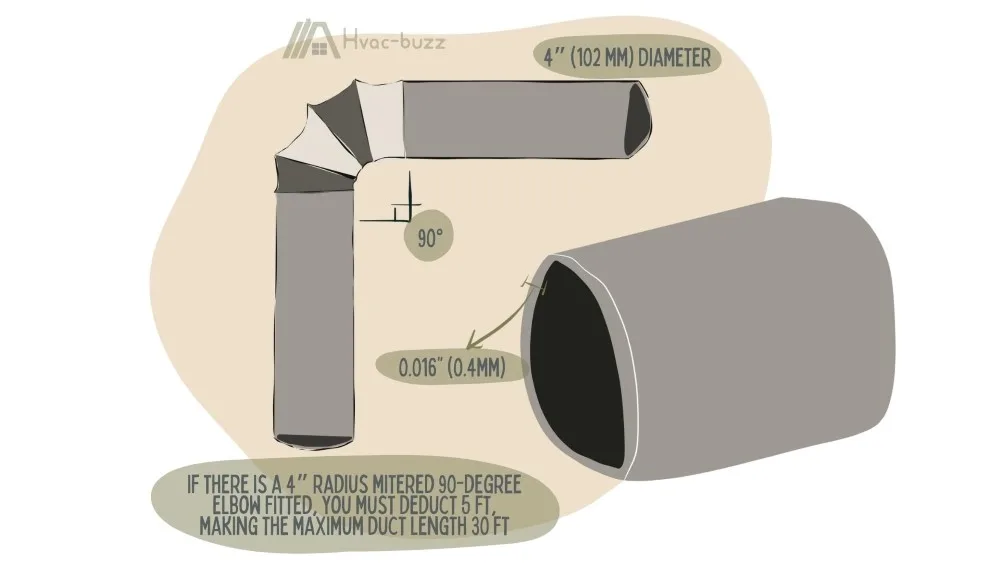Gas dryers are a definite must for most suburban families, but which room is best for installation? With more families looking at downsizing, a gas dryer in the bathroom seems convenient. However, one needs to consider the risks involved with a gas appliance and building codes regarding its location.
This article investigates the regulations around gas dryer installations, what are the exceptions should one insist on installing this appliance in one of the most popular rooms in a home. It also elaborates on the risks involved and guidelines for duct installations.

The IRC prohibits gas dryer installation in a bathroom unless it is a direct-vent appliance, and the bathroom has adequate ventilation. All installation regulations provided in the code must still be adhered to.
Bathrooms Usually Prohibited Location
The International Residential Code (IRC) says in Section G2406.2 that fuel gas appliances should not be installed within small and poorly ventilated rooms such as bathrooms, toilet rooms, sleeping rooms, closets, and surgical rooms.
Gas dryers need large volumes of quality combustion air and the minimum volume needed for complete combustion is 50 cubic feet per 1000 Btu/h.
Exception
However, if you still wish to install a gas dryer in your bathroom, there are some exceptions. The IRC states in Section G2406.2 that you can install a gas dryer in your bathroom if:
“The appliance is a direct-vent appliance installed in accordance with the conditions of listing and the manufacturer’s instructions.”

One needs to ensure the dryer will receive large volumes of combustion air directly from the outside of one’s home and can also expel exhaust air to the outside of one’s home.
The IRC also states in Section G2406.2 that:
“A clothes dryer is installed in a residential bathroom or toilet room having a permanent opening with an area of not less than 100 square inches (0.06 m2) that communicates with a space outside of a sleeping room, bathroom, toilet room or storage closet.”
Because some bathrooms don’t have windows and the door is usually closed for long periods, adequate ventilation may not occur (poor bathroom ventilation is not just a problem when you have a gas dryer). A permanent opening from a larger space may ensure proper ventilation.
Check Your Local Codes
It is always important to check the codes that are specific to your relevant state as each state may endure different living conditions.
Some states may have higher temperatures than others or experience more natural disasters than others which could alter gas dryer installation regulations.
Potential Hazards of Gas Dryers in Bathrooms
Fire Hazard
Over time gas dryers would have dried a few loads of dirty laundry, which would essentially lead to a build-up of lint, a highly flammable substance, within the dryer’s exhaust ducts and lint filter.
The high levels of moisture in bathroom air also add to the heaviness of the lint making it easier to clump together and accumulate in these areas.
This build-up begins to restrict the outflow of heated exhaust air and causes the dryer to overheat and generate sparks that can easily set the lint a light. The fire could then spreads through the rest of the house through the ducts.
Bathrooms may also have high concentrations of flammable substances in the air from hair sprays, deodorants, and toilets sprays, which may not pair well with an overheating gas dryer!
However, lint build-up can be prevented with adequate maintenance and avid cleaning of the dryer lint filter.
Carbon Monoxide Poisoning
Bathrooms potentially have low volumes of combustion air, which can lead to incomplete combustion within the dryer.

This produces small amounts of carbon monoxide and because the bathroom is usually one of the most frequently used rooms in one’s home, there is a higher risk of long-term exposure leading to carbon monoxide poisoning.
However, this may be monitored by installing a carbon monoxide detector in the bathroom with the gas dryer.
Moisture Build-Up
Unless proper ventilation is installed with the or exhaust ducts is leading to the outside of a home, moisture will remain in your bathroom leading to mold problems and structural damage.

Benefits of Gas Dryer in Bathroom
There are a few benefits that come with having a gas dryer, such as it being cost-effective.
One wouldn’t need to have an additional electrical outlet installed as would be necessary with an electrical dryer. Electrical outlets in bathrooms are not recommended.
This choice in setup is also convenient when drying wet towels after a relaxing shower because let’s be honest, wet towels usually land up on the floor or take forever to dry in humid spaces.
If one lives in a small-spaced condominium, having a gas dryer in the bathroom is a space saver, aesthetically pleasing, and keeps the bathroom nice and toasty.
However, these benefits are not typically enough to outweigh the potential hazards.
Gas Dryer Installation Guidelines
Exhaust Duct Installation
Installation of dyer exhaust systems should follow manufacturer instructions and avoid interference and interconnections with surrounding systems.
As per Section G2439.3 of the IRC:
- Dryer ducts must channel moisture to the outside.
- The vent terminals should have no screens.
- Ducts must not be installed with fasteners.
- Ensure backdraft dampers are fitted.
The prohibition of screens and fasteners is to ensure that lint has limited surfaces on which it can catch and build up. Backdraft dampers prevent reverse airflow in ducts.
Printable dryer venting checklist
If the volume of discarded air is more than 200 CFM (0.09 m3/s), make-up air (a system drawing fresh air from outside to replace discarded air) will have to be provided. You can find this regulation in IRC Section G2439.5.
Without this replacement, a significant air pressure imbalance is created. Furthermore, it increases the chance of incomplete combustion occurring.
In IRC Section G2439.7.1 and Section G2439.7.2, it says:
- Ducts should be made of 0.016” (0.4 mm) thick metal.
- Duct diameter must be 4” (102 mm).
- Ducts should be supported and secured every 4 ft (1219 mm).
- Where the duct joins the dryer or another portion of ducting, it must be inserted in the direction of airflow.
- Ducts cannot be deformed; they must fit in the space through which they are running.
Duct Length

The maximum duct length you would need to use depends on type and number of duct fittings you use.
The manufacturer’s instructions and power of the duct ventilator also influence the total duct length you would need. If no instructions are provided, it is advised to refer to Table G2439.7.4.1.
The absolute maximum length from the transition duct (the duct connecting the dryer to the exhaust duct) to the duct terminal is 35 ft (10 668 mm). However, as presented in the table in Section G2439.7.4 of the IRC, adding fittings reduces the allowable lengths by specific amounts.
For example, if there is a 4” radius mitered 90-degree elbow fitted, you must deduct 5 ft, making the maximum length 30 ft.
Why Length Decreases With the Addition of Fittings
The moist, lint-containing air from the dryer is moved along the duct under the mechanical forces created by the dryer. These forces are opposed by friction exerted by the ducts. Joins and turns create more friction than the smooth duct surfaces (you cannot use flexi duct for dryers).
If the combined fitting friction becomes too high, then the dryer will not be strong enough to move the air successfully through the full length of the duct, unless the total length was reduced, eliminating a portion of the surface area adding to the friction.
Recommendation: Call an Expert
Trying to adhere to every regulation can be tricky and even though this may seem like a great challenge for all the DIY fans out there, it is best to get in touch with an expert that is familiar with your local codes and can assess your bathroom professionally.
Most professional plumbers charge an hourly rate of about $45 to $200, not a bad price to pay to ensure the safety of loved ones.
Related article: Can a Gas Water Heater Be Installed in a Bathroom
Sources
https://www.fixr.com/costs/plumbing
https://forum.nachi.org/t/natural-gas-dryer-in-bathroom/13599/16
https://www.nachi.org/dryer-vent-safety.htm
https://www.houzz.com/discussions/2424940/gas-dryer-in-a-small-room
https://dryerbox.com/dryer_venting_guide.htm
https://www.youtube.com/watch?v=mcipN8bvpa0
https://www.bpihomeowner.org/blog/things-you-should-know-dryer-vents-can-be-fire-hazard
https://www.thebuildingcodeforum.com/forum/threads/gas-dryer-in-bathroom.10954/
https://greengarageblog.org/15-gas-vs-electric-dryers-pros-and-cons
http://www.dryerventcleaningwi.com/DryingTimeNews/CarbonMonoxide
https://www.cse.org.uk/advice/advice-and-support/damp-condensation
https://homedetoxing.com/does-a-dryer-give-off-carbon-monoxide/
https://www.b4ubuild.com/links/codes.shtml
http://www.dryerventcleaningwi.com/DryingTimeNews/CarbonMonoxide
https://www.health.state.mn.us/communities/environment/air/toxins/index.html
https://www.inspectorsjournal.com/topic/9387-gas-dryer/
https://codes.iccsafe.org/content/IRC2021P1/chapter-24-fuel-gas
